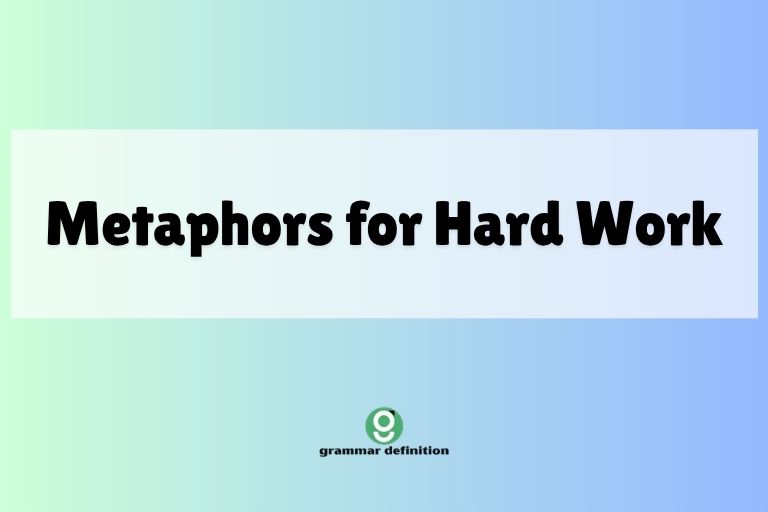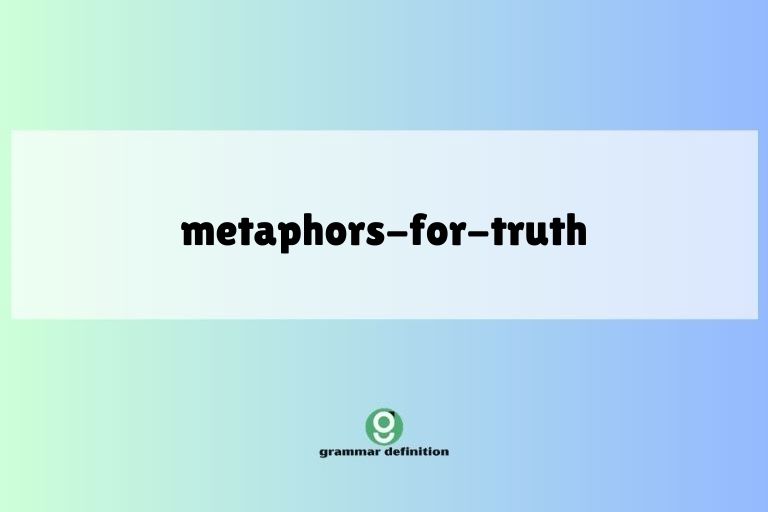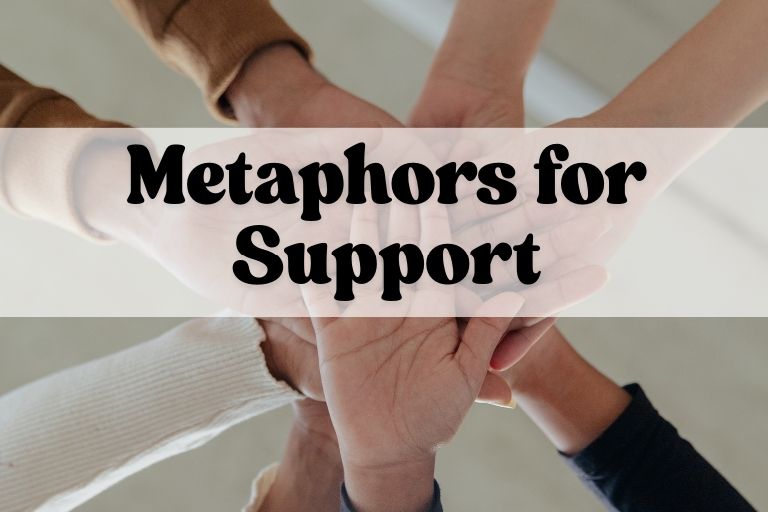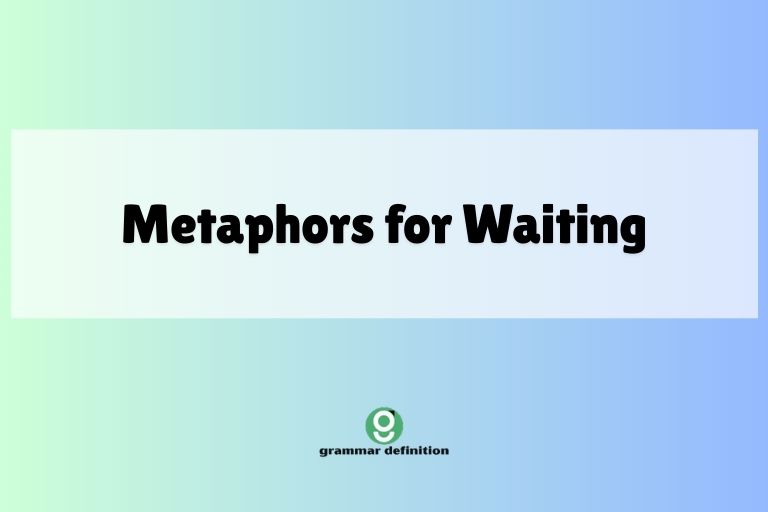Addiction Metaphors: Understanding Language’s Impact
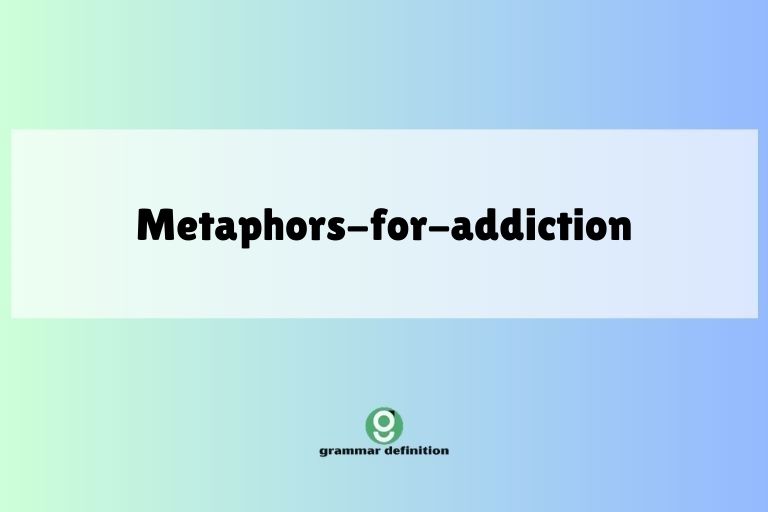
Metaphors are powerful tools that shape our understanding of complex concepts. When it comes to addiction, metaphors are not merely decorative; they profoundly influence how we perceive, discuss, and treat this challenging condition.
Understanding the metaphors we use for addiction is crucial for fostering empathy, promoting effective communication, and developing more nuanced approaches to recovery. This article delves into the various metaphors used to describe addiction, examining their implications and offering insights into their impact on language and perception.
This article is for anyone interested in English grammar, linguistics, psychology, or addiction studies, but especially for ESL learners who want to improve their understanding of expressive language and its cultural contexts.
By exploring the grammatical structures and semantic nuances of addiction metaphors, we can gain a deeper appreciation for the multifaceted nature of addiction and its impact on individuals, families, and communities. This comprehensive guide will provide detailed explanations, examples, and practice exercises to enhance your grasp of this vital aspect of language and its connection to real-world issues.
Table of Contents
- Introduction
- Definition of Metaphor and Addiction Metaphors
- Structural Breakdown of Addiction Metaphors
- Types and Categories of Addiction Metaphors
- War Metaphor
- Disease Metaphor
- Slavery Metaphor
- Journey Metaphor
- Monster Metaphor
- Other Common Metaphors
- Examples of Addiction Metaphors
- War Metaphor Examples
- Disease Metaphor Examples
- Slavery Metaphor Examples
- Journey Metaphor Examples
- Monster Metaphor Examples
- Usage Rules for Addiction Metaphors
- Common Mistakes When Using Addiction Metaphors
- Practice Exercises
- Advanced Topics in Addiction Metaphors
- Frequently Asked Questions (FAQ)
- Conclusion
Definition of Metaphor and Addiction Metaphors
What is a Metaphor?
A metaphor is a figure of speech that directly compares two unrelated things without using “like” or “as.” It asserts that one thing *is* another, implying a similarity or shared characteristic between them. This comparison is not literal but figurative, designed to create a vivid image or convey a deeper meaning.
Metaphors are essential for abstract thinking and communicating complex ideas in an accessible way. They allow us to understand something unfamiliar by relating it to something we already know.
For example, saying “time is money” doesn’t mean time can be exchanged for currency. Instead, it suggests that time, like money, is a valuable resource that should be carefully managed and not wasted.
The effectiveness of a metaphor lies in its ability to evoke a strong mental image and foster a new understanding of the concept being described.
What are Addiction Metaphors?
Addiction metaphors are specific types of metaphors used to describe the experience, causes, and consequences of addiction. Because addiction is a complex phenomenon involving physical, psychological, and social factors, metaphors are often used to simplify and explain it.
These metaphors can shape our understanding of addiction, influencing attitudes about treatment, recovery, and the individuals affected.
For instance, describing addiction as a “disease” frames it as a medical condition requiring treatment and care. On the other hand, portraying it as a “moral failing” suggests a lack of willpower or character.
The choice of metaphor can have significant implications for how addiction is addressed and perceived.
Function of Metaphors
Metaphors serve several crucial functions in language and thought, particularly in the context of addiction:
- Simplification: They simplify complex and abstract concepts, making them easier to understand.
- Emotional Impact: They evoke strong emotions and create vivid imagery, enhancing the impact of communication.
- Perspective Shaping: They shape our perspective and influence our attitudes toward addiction and those affected by it.
- Communication: They provide a common framework for discussing addiction, facilitating communication among individuals, families, and professionals.
- Motivation: They can motivate individuals to seek help and support by framing addiction in a way that encourages action.
Effective metaphors can promote empathy and understanding, while poorly chosen metaphors can perpetuate stigma and misunderstanding. It’s essential to be mindful of the metaphors we use and their potential impact.
Contexts of Use
Addiction metaphors are used in a wide range of contexts, including:
- Personal Narratives: Individuals with addiction often use metaphors to describe their experiences.
- Therapeutic Settings: Therapists and counselors use metaphors to help clients understand and process their addiction.
- Public Health Campaigns: Public health organizations use metaphors to raise awareness and promote prevention efforts.
- Media Reporting: News outlets and journalists use metaphors to report on addiction-related issues.
- Academic Research: Researchers use metaphors to frame their understanding of addiction and to communicate their findings.
The specific metaphors used in each context may vary depending on the audience, the purpose of the communication, and the prevailing cultural attitudes toward addiction. For example, a therapist might use a “journey” metaphor to encourage a client’s progress in recovery, while a public health campaign might use a “war” metaphor to emphasize the urgency of addressing the addiction crisis.
Structural Breakdown of Addiction Metaphors
Understanding the structure of metaphors is essential for analyzing their meaning and impact. A metaphor typically involves two key elements: the source domain and the target domain.
Source Domain
The source domain is the concept or area of experience that is used to understand the target domain. It’s the familiar or concrete idea that provides a framework for understanding the less familiar or abstract concept.
For example, in the metaphor “addiction is a war,” the source domain is *war*. We understand war as a struggle involving battles, strategies, and enemies.
Target Domain
The target domain is the concept or area of experience that is being understood through the metaphor. In the context of addiction metaphors, the target domain is *addiction* itself.
Using the same example, “addiction is a war,” the target domain is addiction. We are trying to understand addiction by relating it to the familiar concept of war.
Mapping
Mapping refers to the process of connecting elements from the source domain to elements in the target domain. This involves identifying similarities or correspondences between the two domains.
In the “addiction is a war” metaphor, the mapping might include:
- Addiction = War
- Substance = Enemy
- Recovery = Victory
- Treatment = Strategy
- Cravings = Battles
The mapping allows us to transfer our understanding of the source domain (war) to the target domain (addiction), providing a new perspective on the latter.
Examples of Structural Mapping
Let’s look at more examples to illustrate the structural mapping process:
| Metaphor | Source Domain | Target Domain | Mapping |
|---|---|---|---|
| Addiction is a disease | Disease | Addiction |
|
| Addiction is slavery | Slavery | Addiction |
|
| Addiction is a journey | Journey | Addiction |
|
This table demonstrates how different source domains can be used to understand the target domain of addiction, each providing a unique perspective and set of associations.
Types and Categories of Addiction Metaphors
Addiction metaphors can be categorized based on the source domain they draw from. Here are some of the most common categories:
War Metaphor
The war metaphor frames addiction as a battle against an enemy. This enemy can be the substance itself, cravings, or the addiction.
This metaphor often emphasizes the need for strength, strategy, and determination to overcome addiction. It can be motivating but also potentially stigmatizing, as it can create a sense of blame or shame if the “battle” is lost.
Examples include: “fighting addiction,” “battling cravings,” “winning the war against drugs.”
Disease Metaphor
The disease metaphor views addiction as a medical condition, similar to diabetes or heart disease. This perspective emphasizes the biological and psychological factors contributing to addiction and the need for medical treatment and support.
It can reduce stigma and promote empathy, but it can also be seen as absolving individuals of personal responsibility.
Examples include: “addiction is a chronic disease,” “suffering from addiction,” “treating addiction.”
Slavery Metaphor
The slavery metaphor portrays addiction as a state of being controlled or enslaved by a substance or behavior. This metaphor highlights the loss of freedom and autonomy experienced by individuals with addiction.
It can be empowering by acknowledging the powerful hold addiction has, but it can also be disempowering by suggesting a lack of control.
Examples include: “enslaved by addiction,” “a slave to drugs,” “breaking free from addiction.”
Journey Metaphor
The journey metaphor frames recovery as a path or voyage. This metaphor emphasizes the process of change and growth involved in overcoming addiction.
It can be encouraging and hopeful, highlighting the possibility of progress and transformation. It also acknowledges that recovery is not always linear and may involve setbacks and challenges.
Examples include: “the road to recovery,” “on a journey to sobriety,” “navigating the challenges of recovery.”
Monster Metaphor
The monster metaphor depicts addiction as a destructive and malevolent force. This metaphor underscores the devastating impact addiction can have on individuals and their families.
It can be used to highlight the severity of the problem and the need for intervention, but it can also be stigmatizing and dehumanizing.
Examples include: “addiction is a monster,” “battling the beast of addiction,” “the grip of addiction.”
Other Common Metaphors
Besides the main categories above, there are other recurring metaphors:
- Trap Metaphor: Addiction as a trap that individuals fall into and struggle to escape.
- Darkness/Light Metaphor: Addiction as darkness and recovery as light.
- Weight Metaphor: Addiction as a heavy burden.
- Storm Metaphor: Addiction as a turbulent storm.
Each of these metaphors provides a different lens through which to view addiction, highlighting different aspects of the experience and influencing our understanding and response.
Examples of Addiction Metaphors
To further illustrate the different categories of addiction metaphors, here are several examples organized by category:
War Metaphor Examples
The war metaphor is frequently used to describe the struggle against addiction, framing it as a battle that requires strength and strategy.
| Example | Explanation |
|---|---|
| “He’s fighting a tough battle with his addiction.” | Implies addiction is an enemy that must be fought. |
| “She’s waging a war against her cravings.” | Cravings are portrayed as enemy forces. |
| “We must win the war on drugs.” | Addiction is framed as a large-scale conflict. |
| “He lost the battle with his addiction.” | Relapse is seen as a defeat. |
| “She’s on the front lines of recovery.” | Recovery is depicted as a dangerous and challenging place. |
| “He armed himself with coping strategies.” | Coping mechanisms are seen as weapons. |
| “She’s a survivor of the addiction war.” | Highlights resilience and perseverance. |
| “The enemy is cunning and relentless.” | Describes the addictive substance as an adversary. |
| “Treatment is his strategic plan of attack.” | Frames treatment as a planned approach. |
| “He’s a casualty of the drug war.” | Emphasizes the destructive consequences of addiction. |
| “She’s digging in for a long fight.” | Implies recovery will be a prolonged struggle. |
| “He’s fortified himself against temptation.” | Describes strengthening oneself against cravings. |
| “The community is mobilizing to combat addiction.” | Portrays community efforts as a military campaign. |
| “He’s launching a counterattack on his bad habits.” | Implies taking proactive steps to change. |
| “She’s taking aim at her triggers.” | Describes identifying and addressing triggers. |
| “He’s using every weapon in his arsenal to stay sober.” | Highlights the use of various coping mechanisms. |
| “She’s trying to outmaneuver her addiction.” | Emphasizes the need for strategic thinking. |
| “He’s holding the line against relapse.” | Portrays resisting relapse as a defensive action. |
| “She’s regrouping after a setback.” | Describes recovering from a relapse. |
| “He’s declaring victory over his addiction.” | Implies successful recovery. |
| “She’s a veteran of the fight against substance abuse.” | Highlights experience and resilience. |
| “The battleground is her own mind.” | Emphasizes the internal struggle of addiction. |
| “He’s enlisting support in his fight.” | Describes seeking help from others. |
| “She’s using her willpower as her strongest weapon.” | Highlights the importance of determination. |
| “He’s a warrior in recovery.” | Portrays strength and courage in overcoming addiction. |
These examples illustrate how the war metaphor can be used to describe various aspects of addiction, from the initial struggle to the ongoing process of recovery.
Disease Metaphor Examples
The disease metaphor frames addiction as a medical condition, emphasizing the need for treatment and care.
| Example | Explanation |
|---|---|
| “Addiction is a chronic disease.” | Compares addiction to long-term illnesses like diabetes. |
| “He’s suffering from the disease of addiction.” | Portrays addiction as a source of pain and illness. |
| “She’s in treatment for her addiction.” | Frames addiction as a condition requiring medical intervention. |
| “Relapse is a common symptom of addiction.” | Normalizes relapse as part of the disease process. |
| “Addiction is a progressive illness.” | Highlights the worsening nature of addiction over time. |
| “He’s managing his addiction with medication.” | Compares addiction management to managing other diseases. |
| “She’s seeking a cure for her addiction.” | Portrays recovery as a form of healing. |
| “Addiction is a public health crisis.” | Frames addiction as a widespread medical problem. |
| “He’s genetically predisposed to addiction.” | Highlights the biological factors of addiction. |
| “She’s experiencing withdrawal symptoms.” | Describes the physical effects of stopping substance use. |
| “Addiction is a complex disorder.” | Emphasizes the multifaceted nature of addiction. |
| “He’s in remission from his addiction.” | Compares recovery to being in remission from cancer. |
| “She’s consulting with a specialist about her addiction.” | Frames addiction as a condition requiring expert care. |
| “Addiction is a treatable condition.” | Offers hope for recovery. |
| “He’s taking preventative measures against relapse.” | Compares relapse prevention to disease prevention. |
| “She’s showing signs of improvement in her addiction.” | Describes progress in recovery. |
| “Addiction is a debilitating disease.” | Highlights the disabling effects of addiction. |
| “He’s following a strict treatment regimen.” | Compares addiction treatment to medical treatment. |
| “She’s undergoing intensive therapy for her addiction.” | Frames therapy as a medical intervention. |
| “Addiction is a disease that affects the whole family.” | Emphasizes the impact on loved ones. |
| “He’s seeking a second opinion on his treatment plan.” | Compares addiction treatment to medical treatment. |
| “She’s monitoring her symptoms closely.” | Describes self-awareness and management of addiction. |
| “Addiction is a relapsing disease.” | Highlights the chronic nature of addiction. |
| “He’s learning to cope with his condition.” | Compares addiction to other chronic illnesses. |
| “She’s participating in a support group for her disease.” | Frames addiction as a condition requiring peer support. |
By framing addiction as a disease, these examples emphasize the need for medical and psychological support, reducing stigma and promoting empathy.
Slavery Metaphor Examples
The slavery metaphor highlights the loss of control and autonomy experienced by individuals with addiction.
| Example | Explanation |
|---|---|
| “He’s enslaved by his addiction.” | Describes addiction as a form of bondage. |
| “She’s a slave to drugs.” | Highlights the lack of freedom. |
| “He’s breaking free from the chains of addiction.” | Portrays recovery as liberation. |
| “She’s shackled by her cravings.” | Cravings are seen as restraints. |
| “Addiction has him in its grip.” | Emphasizes the controlling power of addiction. |
| “He’s a prisoner of his own habits.” | Highlights the self-destructive nature of addiction. |
| “She’s fighting for her freedom from addiction.” | Portrays recovery as a struggle for liberty. |
| “He’s a captive of his desires.” | Describes being controlled by cravings. |
| “She’s escaping the bonds of addiction.” | Highlights the process of breaking free. |
| “Addiction is his master.” | Emphasizes the controlling influence of addiction. |
| “He’s manacled by his past.” | Describes being held back by previous experiences. |
| “She’s throwing off the yoke of addiction.” | Portrays recovery as removing a burden. |
| “He’s liberating himself from substance abuse.” | Highlights the act of freeing oneself. |
| “She’s no longer a pawn of addiction.” | Emphasizes regaining control. |
| “He’s emancipating himself from his vices.” | Describes freeing oneself from bad habits. |
| “She’s refusing to be held hostage by her addiction.” | Portrays resistance to addiction’s control. |
| “He’s breaking the shackles of dependency.” | Highlights the act of ending dependence. |
| “She’s reclaiming her life from addiction’s grasp.” | Emphasizes regaining control and purpose. |
| “He’s shedding the chains of his old life.” | Describes leaving behind the past. |
| “She’s seeking asylum from her addiction.” | Portrays seeking refuge from addiction. |
| “He’s determined to unshackle himself from his demons.” | Highlights the determination to overcome challenges. |
| “She’s rewriting her story, free from addiction’s control.” | Emphasizes creating a new future. |
| “He’s finding liberation in sobriety.” | Describes the freedom found in recovery. |
| “She’s breaking the cycle of enslavement.” | Highlights ending the pattern of addiction. |
| “He’s declaring his independence from substance abuse.” | Portrays taking control of one’s life. |
These examples illustrate how the slavery metaphor can convey the profound sense of loss and the struggle for freedom associated with addiction.
Journey Metaphor Examples
The journey metaphor frames recovery as a path or voyage, emphasizing the process of change and growth.
| Example | Explanation |
|---|---|
| “He’s on the road to recovery.” | Describes recovery as a path. |
| “She’s navigating the challenges of recovery.” | Portrays recovery as a journey with obstacles. |
| “He’s making progress on his journey to sobriety.” | Highlights forward movement. |
| “She’s taking steps towards a better life.” | Emphasizes incremental progress. |
| “He’s at a crossroads in his recovery.” | Describes a point of decision. |
| “She’s charting a new course for her life.” | Portrays planning a new future. |
| “He’s finding his way back to health.” | Highlights the return to well-being. |
| “She’s climbing the mountain of recovery.” | Emphasizes the effort required. |
| “He’s reaching milestones in his recovery journey.” | Describes achieving significant goals. |
| “She’s finding strength for the path ahead.” | Highlights the need for resilience. |
| “He’s encountering obstacles along the way.” | Acknowledges the challenges of recovery. |
| “She’s seeking guidance on her journey.” | Portrays seeking support from others. |
| “He’s packing his bags for a new adventure.” | Describes preparing for a new life. |
| “She’s mapping out her recovery plan.” | Emphasizes planning and strategy. |
| “He’s setting sail towards a brighter future.” | Portrays moving towards a positive outcome. |
| “She’s finding her footing on the recovery path.” | Highlights gaining stability. |
| “He’s taking a detour to address his trauma.” | Describes addressing underlying issues. |
| “She’s reaching the summit of her recovery.” | Portrays achieving the ultimate goal. |
| “He’s looking back on his journey with pride.” | Emphasizes the sense of accomplishment. |
| “She’s sharing her story to light the way for others.” | Portrays helping others on their journey. |
| “He’s using his experiences to guide others along the path.” | Highlights the role of mentorship. |
| “She’s continuing her journey of self-discovery.” | Emphasizes ongoing personal growth. |
| “He’s learning to navigate the ups and downs of recovery.” | Acknowledges the fluctuating nature of progress. |
| “She’s embracing the unknown on her path to healing.” | Portrays openness to new experiences. |
| “He’s celebrating each milestone along the way.” | Highlights the importance of recognizing progress. |
By framing recovery as a journey, these examples emphasize the ongoing nature of the process and the potential for growth and transformation.
Monster Metaphor Examples
This metaphor depicts addiction as a destructive force, often emphasizing its negative impact on individuals and their families.
| Example | Explanation |
|---|---|
| “Addiction is a monster that devours lives.” | Portrays addiction as a destructive entity. |
| “He’s battling the beast of addiction.” | Describes fighting a powerful, monstrous force. |
| “She’s trapped in the clutches of addiction.” | Emphasizes the controlling grip of addiction. |
| “He’s haunted by the specter of his addiction.” | Portrays addiction as a persistent, ghostly presence. |
| “She’s wrestling with her inner demons.” | Describes fighting internal struggles. |
| “He’s trying to slay the dragon of addiction.” | Portrays recovery as a heroic quest. |
| “She’s escaping the lair of addiction.” | Highlights the act of breaking free. |
| “He’s trying to exorcise his addiction.” | Describes removing a malevolent force. |
| “She’s confronting the shadow of her past.” | Portrays facing difficult memories. |
| “He’s trying to tame the wild beast within.” | Describes controlling impulsive behaviors. |
| “She’s fighting to keep the monster at bay.” | Highlights the ongoing struggle. |
| “He’s trying to banish the darkness of addiction.” | Portrays recovery as bringing light. |
| “She’s breaking free from the curse of addiction.” | Emphasizes ending a negative cycle. |
| “He’s trying to conquer his inner demons.” | Describes overcoming personal challenges. |
| “She’s standing up to the bully of addiction.” | Portrays addiction as an oppressive force. |
| “He’s refusing to let the monster win.” | Highlights determination to overcome addiction. |
| “She’s learning to control the demons that haunt her.” | Emphasizes self-management and coping skills. |
| “He’s seeking to vanquish the darkness within.” | Portrays recovery as overcoming internal struggles. |
| “She’s determined to prevent the monster from returning.” | Highlights relapse prevention strategies. |
| “He’s finding strength to fight the beast every day.” | Emphasizes daily commitment to recovery. |
| “She’s learning to live with the scars left by the monster.” | Portrays accepting the lasting effects of addiction. |
| “He’s using his experience to warn others about the monster.” | Highlights the role of advocacy and prevention. |
| “She’s determined to keep the monster locked away forever.” | Emphasizes long-term commitment to sobriety. |
| “He’s finding peace after years of battling the beast.” | Portrays the eventual rewards of recovery. |
| “She’s creating a safe haven to protect herself from the monster.” | Highlights the importance of supportive environments. |
These examples illustrate how the monster metaphor can be used to convey the destructive power of addiction and the challenges of recovery.
Usage Rules for Addiction Metaphors
While metaphors can be powerful and effective, it’s important to use them thoughtfully and responsibly. Here are some usage rules to consider when using addiction metaphors:
Appropriateness and Sensitivity
Choose metaphors that are appropriate for the audience and context. Avoid metaphors that are stigmatizing, dehumanizing, or insensitive to the experiences of individuals with addiction.
For example, while the “war” metaphor can be motivating, it can also be seen as blaming individuals for their addiction.
Consider the potential impact of the metaphor on the individuals you are communicating with. If you are unsure whether a metaphor is appropriate, it’s best to err on the side of caution and choose a different one.
Clarity and Effectiveness
Use metaphors that are clear and easy to understand. Avoid metaphors that are too complex or obscure, as they may confuse your audience and undermine your message.
The most effective metaphors are those that resonate with the audience’s existing knowledge and experiences.
Ensure that the mapping between the source domain and the target domain is clear and logical. The connections between the two domains should be obvious and easy to grasp.
Consistency
Maintain consistency in your use of metaphors. Avoid mixing metaphors or switching between different metaphors in a way that is confusing or contradictory.
If you start with the “disease” metaphor, stick with it throughout your communication.
Inconsistency can weaken your message and undermine your credibility. Choose a metaphor that you are comfortable with and that you can use consistently throughout your communication.
Common Mistakes When Using Addiction Metaphors
Several common mistakes can undermine the effectiveness and appropriateness of addiction metaphors. Being aware of these pitfalls helps ensure that your communication is clear, respectful, and impactful.
- Mixing Metaphors: Combining different metaphors that create a confusing or contradictory image.
Incorrect: “He’s fighting the disease of addiction on the road to recovery.” Mixing “war” and “journey” metaphors.
Correct: “He’s fighting the battle against addiction.” Consistent war metaphor.
Correct: “He’s on the road to recovery from addiction.” Consistent journey metaphor.
- Using Stigmatizing Language: Employing metaphors that reinforce negative stereotypes or blame individuals for their addiction.
Incorrect: “She’s a monster for using drugs.” Dehumanizing and stigmatizing.
Correct: “Addiction is a monster that has taken hold of her life.” Focuses on the addiction, not the person.
- Oversimplifying Complex Issues: Reducing the complexity of addiction to a single, simplistic metaphor that doesn’t capture the full picture.
Incorrect: “Addiction is just a matter of willpower.” Oversimplifies the biological and psychological factors.
Correct: “Addiction is a complex disease involving biological, psychological, and social factors.” Acknowledges the multifaceted nature of addiction.
- Using Clichéd Metaphors: Relying on overused metaphors that have lost their impact and originality.
Incorrect: “He’s battling his demons.” Clichéd and lacks specificity.
Correct: “He’s confronting the underlying trauma that fuels his addiction.” More specific and impactful.
- Misunderstanding the Mapping: Failing to establish a clear and logical connection between the source and target domains, leading to confusion.
Incorrect: “Addiction is a sunny day.” The connection between addiction and a sunny day is unclear.
Correct: “Recovery is a sunny day after a long storm.” The connection between recovery and a sunny day is clear.
Practice Exercises
These exercises will help you practice identifying and creating effective addiction metaphors.
Exercise 1: Identifying Metaphors
Identify the metaphor in each of the following sentences and explain the source and target domains.
- “She’s drowning in her addiction.”
- “He’s building a foundation for recovery.”
- “Addiction is a thief that steals lives.”
- “She’s lost in the darkness of addiction.”
- “He’s planting seeds of hope for a better future.”
Answers:
-
Metaphor: Drowning in her addiction.
Source Domain: Drowning
Target Domain: Addiction
Explanation: Addiction is portrayed as an overwhelming force that engulfs and suffocates a person.
-
Metaphor: Building a foundation for recovery.
Source Domain: Building a foundation
Target Domain: Recovery
Explanation: Recovery is portrayed as a process of constructing a stable and solid base for a new life.
-
Metaphor: Addiction is a thief that steals lives.
Source Domain: Thief
Target Domain: Addiction
Explanation: Addiction is portrayed as a criminal that robs individuals of their health, relationships, and opportunities.
-
Metaphor: Lost in the darkness of addiction.
Source Domain: Darkness
Target Domain: Addiction
Explanation: Addiction is portrayed as a state of confusion, isolation, and despair.
-
Metaphor: Planting seeds of hope for a better future.
Source Domain: Planting seeds
Target Domain: Recovery
Explanation: Recovery is portrayed as a process of nurturing and cultivating positive changes for a brighter future.
Exercise 2: Creating Metaphors
Create a metaphor for addiction using each of the following source domains:
- Weather
- Navigation
- Gardening
- Music
- Sports
Example Answers:
-
Source Domain: Weather
Addiction is a hurricane that devastates everything in its path.
-
Source Domain: Navigation
Recovery is like navigating a ship through a storm, requiring skill, resilience, and a clear destination.
-
Source Domain: Gardening
Addiction is like weeds choking the flowers in a garden, requiring constant vigilance and care to remove.
-
Source Domain: Music
Addiction is a discordant note in the symphony of life, disrupting harmony and balance.
-
Source Domain: Sports
Recovery is like training for a marathon, requiring dedication, discipline, and perseverance to reach the finish line.
Advanced Topics in Addiction Metaphors
Exploring the nuances of addiction metaphors reveals deeper insights into cultural perspectives and treatment methodologies.
Cultural Variations
The metaphors used to describe addiction can vary significantly across cultures, reflecting different beliefs, values, and social norms. Some cultures may emphasize the spiritual aspects of addiction, while others may focus on the social or economic factors.
Understanding these cultural variations is essential for effective communication and culturally sensitive treatment approaches.
For example, in some indigenous cultures, addiction may be seen as a spiritual imbalance requiring traditional healing practices, while in Western cultures, it is often framed as a medical or psychological issue requiring professional intervention.
Metaphor and Treatment Approaches
The metaphors used in addiction treatment can influence the way individuals perceive their condition and engage in the recovery process. Different treatment approaches may emphasize different metaphors to promote specific goals and outcomes.
For example, a cognitive-behavioral therapy (CBT) approach may use metaphors that emphasize personal responsibility and self-control, while a harm reduction approach may use metaphors that emphasize compassion and acceptance.
By understanding the underlying metaphors of different treatment approaches, individuals can make more informed choices about their care and find the approaches that best resonate with their values and beliefs.
Frequently Asked Questions (FAQ)
What is the best metaphor to use for addiction?
There is no single “best” metaphor for addiction. The most effective metaphor depends on the context, audience, and purpose of the communication.
It’s important to choose a metaphor that is clear, appropriate, and resonant with the individuals you are communicating with.
Are some metaphors for addiction harmful?
Yes, some metaphors can be harmful if they are stigmatizing, dehumanizing, or blame individuals for their addiction. It’s important to avoid metaphors that reinforce negative stereotypes or perpetuate misunderstanding.
How can I use metaphors effectively in addiction communication?
To use metaphors effectively, choose metaphors that are clear, appropriate, and resonant with your audience. Be consistent in your use of metaphors and avoid mixing metaphors that are confusing or contradictory.
Always be mindful of the potential impact of your metaphors and choose them thoughtfully and responsibly.
Can metaphors help reduce stigma around addiction?
Yes, metaphors can help reduce stigma by framing addiction in a more compassionate and understanding way. For example, using the “disease” metaphor can help people see addiction as a medical condition requiring treatment and care, rather than a moral failing.
How do cultural differences affect the use of addiction metaphors?
Cultural differences can significantly affect the use of addiction metaphors, as different cultures may have different beliefs, values, and social norms related to addiction. It’s important to be aware of these cultural differences and to choose metaphors that are culturally sensitive and appropriate.
Conclusion
Metaphors are powerful tools that shape our understanding of addiction and influence our attitudes toward those affected by it. By understanding the different types of addiction metaphors, their structural components, and their potential impact, we can communicate more effectively, promote empathy, and develop more nuanced approaches to treatment and recovery.
It is essential to use metaphors thoughtfully and responsibly, always considering the context, audience, and purpose of our communication. By doing so, we can harness the power of language to foster a more compassionate and understanding world for those struggling with addiction.

